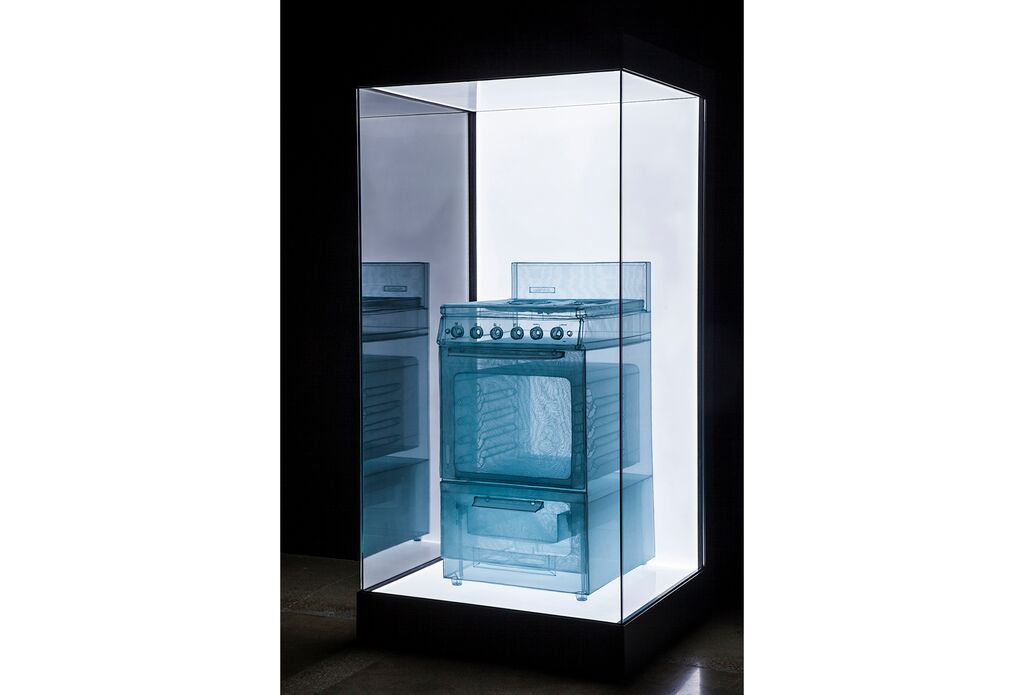Photographer Mintz captures different kind of home
By Carlo Wolff
In the late summer of 2012, Cleveland photographer Charles Mintz presented “Precious Objects,” a show of people with their favorite things, at the Maltz Museum of Jewish Heritage in Beachwood. Now he’s trained his deadpan, open-minded eye on one of the most important parts of people’s lives: their home.
Mintz just published “Lustron Stories,” a book of photographs about a very unusual kind of residence. Published by Trillium Books, a new imprint of The Ohio State University Press, it’s both intimate and affectless. Mintz’s photographs, like the smooth surfaces of Lustron Homes, are oddly opaque yet remarkably expressive.
The $49.95 book is available at Loganberry Books on Cleveland’s Larchmere Boulevard. Mintz has mounted two exhibitions drawing on his Lustron photos and is looking for a local venue to showcase the project.
Lustron Homes are prefab houses of porcelain-baked, enamel-coated steel manufactured in Columbus between 1948 and 1950. About 2,500 were sold, mostly 1,100-square-foot, two-bedroom, one-bath bungalows, to buyers all over the country, from Los Alamos, N.M. to Maine to Miami. About 1,500 survive.
They sold, without land, for $7,000, or close to $71,000 in today’s dollars. In some cases, they’ve remained with the original family. Mintz photographed 125 between 2011 and 2014. Their owners let him into their lives. While the focus is the people, the context is equally eloquent. These photos are nothing if not balanced. Not to mention lived in.
The Lustron project derived from one Mintz embarked on in 2009 to photograph foreclosed homes in every neighborhood in which he’d lived. His research showed that many had been built after either World War I or World War II.
Since he, like Lustron, was born in 1948, “this is history through my lifetime,” said Mintz, who owns a stucco house in Cleveland’s Detroit Shoreway neighborhood. “The project is about the meaning of having your own home.”
Three of the photographs feature members of the original families, including the cover photo of Clementine and her mother, Anita, in Oak Park, Mich.
In that one, there’s the woman who bought the house, Mintz said. “The other story is the daughter who grew up in the house, which I find fascinating. We all remember, most of us, the home we spent the bulk of our childhood in. The house I grew up in in Cleveland Heights was a wooden house but it was essentially the same as these: a two-bedroom, one-bath bungalow built in 1949.”
Lustron Homes sold to a target audience of nondisabled, heterosexual, working-class families, Mintz said. It was the time of “Leave It to Beaver,” of “The Adventures of Ozzie and Harriet,” before the government began to build the interstate system in 1956.
Assembling a Lustron Home might take as few as 350 man hours, he said. But getting the pieces of these low-maintenance, if problematic, homes (you couldn’t nail a picture to a wall, for example) from Columbus to their destinations could be daunting, as semis hauling them had to travel through towns, not to mention on challenging roads. If you had to carry a Lustron Home to, say, Topeka, Kan., you’d have to travel US 40, which in some places was “not much better than a dirt road,” Mintz said. And the semi would have to return to Columbus – empty.
In addition, Lustron ran on money borrowed from the Reconstruction Finance Corp., a federal agency designed to provide economic stimulus, Mintz said.
In “The Idea of Home,” the essay that ends “Lustron Stories,” Mintz says he worked with Ohio History Connection, a Columbus nonprofit and the state’s historical society. Armed with a skeletal database of Lustron Home owners, Mintz wrote “hundreds and hundreds” of letters, eventually connecting with the subjects of these photographs.
“It’s very hard to find volunteers to participate in projects,” he said, “but when you do, with few exceptions, they’re remarkably generous people.” CV
Originally published in the Cleveland Jewish News on Sept. 23, 2016.
Lead image: Charles Mintz framed the Lustron portrait, “Detroit, MI: Miles and Terrence,” in baked enamel, a material similar to that used in Lustron Homes. Photo | Carlo Wolff.











